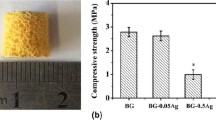Abstract
The objective of this work was to evaluate borate bioactive glass scaffolds (with a composition in the system Na2O–K2O–MgO–CaO–B2O3–P2O5) as devices for the release of the drug Vancomycin in the treatment of bone infection. A solution of ammonium phosphate, with or without dissolved Vancomycin, was used to bond borate glass particles into the shape of pellets. The in vitro degradation of the pellets and their conversion to a hydroxyapatite-type material in a simulated body fluid (SBF) were investigated using weight loss measurements, chemical analysis, X-ray diffraction, and scanning electron microscopy. The results showed that greater than 90% of the glass in the scaffolds degraded within 1 week, to form poorly crystallized hydroxyapatite (HA). Pellets loaded with Vancomycin provided controlled release of the drug over 4 days. Vancomycin-loaded scaffolds were implanted into the right tibiae of rabbits infected with osteomyelitis. The efficacy of the treatment was assessed using microbiological examination and histology. The HA formed in the scaffolds in vivo, resulting from the conversion of the glass, served as structure to support the growth of new bone and blood vessels. The results in this work indicate that bioactive borate glass could provide a promising biodegradable and bioactive material for use as both a drug delivery system and a scaffold for bone repair.








Similar content being viewed by others
References
Mader JT, Landon GC, Calhoun J. Antimicrobial treatment of osteomyelitis. Clin Orthop Relat Res. 1993;295:87–95.
Kanellakopoulou K, Giamarellos-Bourboulis EJ. Carrier systems for the local delivery of antibiotics in bone infections. Drugs. 2000;59:1223–32.
Zhang X, Wyss UP, Pichora D, Goosen MF. Biodegradable controlled antibiotic release devices for osteomyelitis: optimization of release properties. J Pharm Pharmacol. 1994;46:718–24.
Ginebra MP, Traykova T, Planell JA. Calcium phosphate cements as bone drug delivery systems: a review. J Control Release. 2006;113:102–10.
Itokazu M, Ohno T, Tanemori T, Wada E, Kato N, Watanabe K. Antibiotic-loaded hydroxyapatite blocks in the treatment of experimental osteomyelitis in rats. J Med Microbiol. 1997;46:779–83.
Hench LL. Bioceramics. J Am Ceram Soc. 1998;81:1705–28.
Santos EM, Radin S, Ducheyne P. Sol–gel derived carrier for the controlled release of proteins. Biomaterials. 1999;20:1695–700.
Xia W, Chang J. Well-ordered mesoporous bioactive glasses (MBG): a promising bioactive drug delivery system. J Control Release. 2006;110:522–30.
Yao A, Wang D, Huang W, Fu Q, Rahaman MN, Day DE. In vitro bioactive characteristics of borate-based glasses with controllable degradation behavior. J Am Ceram Soc. 2007;90:303–6.
Ning J, Yao A, Wang D, Huang W, Fu H, Liu X, et al. Synthesis and in vitro bioactivity of a borate-based bioglass. Mater Lett. 2007;61:5223–6.
Murray FJ. A human health risk assessment of boron (boric acid and borax) in drinking water. Regul Toxicol Pharmacol. 2005;22:221–30.
Brown RF, Rahaman MN, Dwilewicz AB. Effect of borate glass composition on its conversion to hydroxyapatite and on the proliferation of MC3T3-E1 cells. J Biomed Mater Res A. 2009;88A:392–400.
Xie Z, Liu X, Jia W, Zhang C, Huang W, Wang J. Treatment of osteomyelitis and repair of bone defect by degradable bioactive borate glass releasing vancomycin. J Control Release. 2009;139:118–26.
Dahners LE, Funderburk CH. Gentamicin-loaded plaster of Paris as a treatment of experimental osteomyelitis in rabbits. Clin Orthop Relat Res. 1987;219:278–82.
Norden CW, Myerowitz RL, Keleti E. Experimental osteomyelitis due to Staphylococcus aureus or Pseudomonas aeruginosa: a radiographic-pathological correlative analysis. Br J Exp Pathol. 1980;61:451–60.
Murakami K, Minamide W, Wada K, Nakamura E, Teraoka H, Watanabe S. Identification of methicillin-resistant strains of staphylococci by polymerase chain reaction. J Clin Microbiol. 1991;29:2240–4.
Liu X, Huang W, Fu H, Yao A, Wang D, Pan H, et al. Bioactive borosilicate glass scaffolds: in vitro degradation and bioactivity behaviors. J Mater Sci: Mater Med. 2009;20:1237–43.
Hamadouche M, Meunier A, Greenspan DC, Blanchat C, Zhong JP, La Torre GP, et al. Long-term in vivo bioactivity and degradability of bulk sol-gel bioactive glasses. J Biomed Mater Res. 2001;54:560–6.
Wu F, Wei J, Guo H, Chen F, Hong H, Liu C. Self-setting bioactive calcium–magnesium phosphate cement with high strength and degradability for bone regeneration. Acta Biomater. 2008;4:1873–84.
Nielsen FH. Biochemical and physiologic consequences of boron deprivation in humans. Environ Health Perspect. 1994;102:59–63.
Murray FJ. A comparative review of the pharmacokinetics of boric acid in rodents and humans. Biol Trace Elem Res. 1998;66:331–4.
Final report on the developmental toxicity of boric acid (CAS No. 10043-35-3) in New Zealand White Rabbits, National Toxicology Program (NTP TER-90003) (1991).
National Research Council. Mineral tolerance of animals. 2nd ed. 2005. p. 62–63.
Culver BD, Shen PT, Taylor TH, Lee-Feldstein A, Anton-Culver H, Strong PL. The relationship of blood- and urine-boron to boron exposure in borax-workers and usefulness of urine-boron as an exposure marker. Environ Health Perspect. 1994;102(Suppl 7):133–7.
Webster TJ, Ergun C, Dremus RH, Siegel RW, Bizios R. Specific proteins mediate enhanced osteoblast adhesion on nanophase ceramics. J Biomed Mater Res. 2000;51:475–83.
Wei G, Ma PX. Structure and properties of nano-hydroxyapatite/polymer composite scaffolds for bone tissue engineering. Biomaterials. 2004;25:4749–57.
Acknowledgements
This work was supported by the Shanghai Committee of Science and Technology through the major project (Grant No. 08441900500) and the nano-technology promotion project (Grant No. 0952nm03400).
Author information
Authors and Affiliations
Corresponding authors
Rights and permissions
About this article
Cite this article
Liu, X., Xie, Z., Zhang, C. et al. Bioactive borate glass scaffolds: in vitro and in vivo evaluation for use as a drug delivery system in the treatment of bone infection. J Mater Sci: Mater Med 21, 575–582 (2010). https://doi.org/10.1007/s10856-009-3897-8
Received:
Accepted:
Published:
Issue Date:
DOI: https://doi.org/10.1007/s10856-009-3897-8




